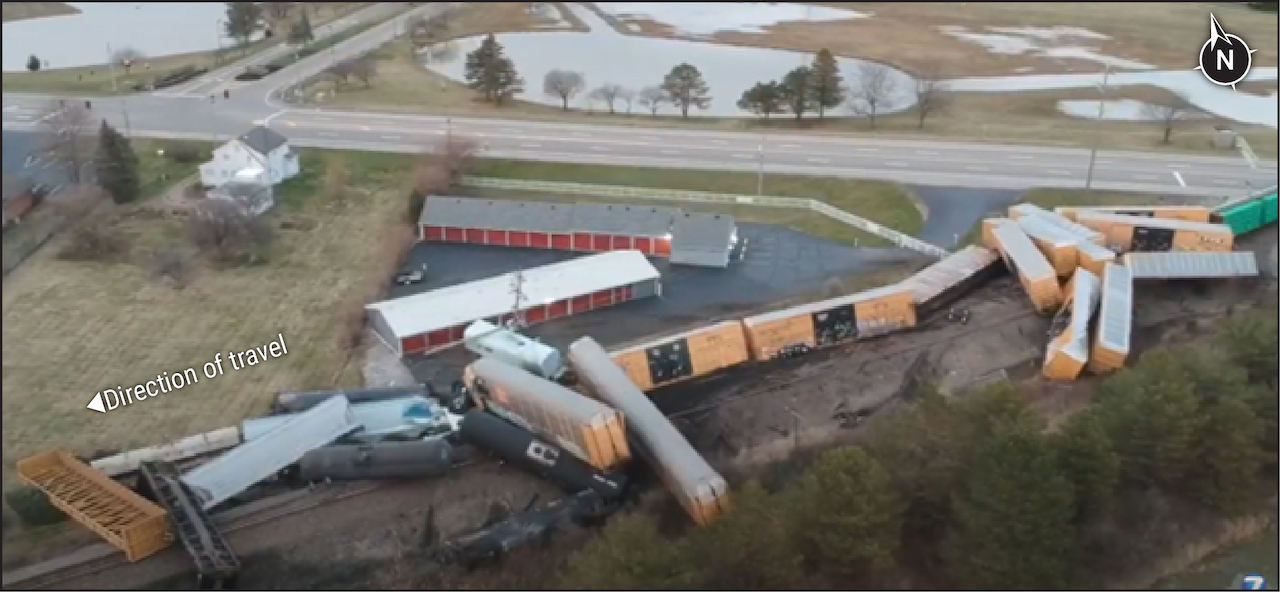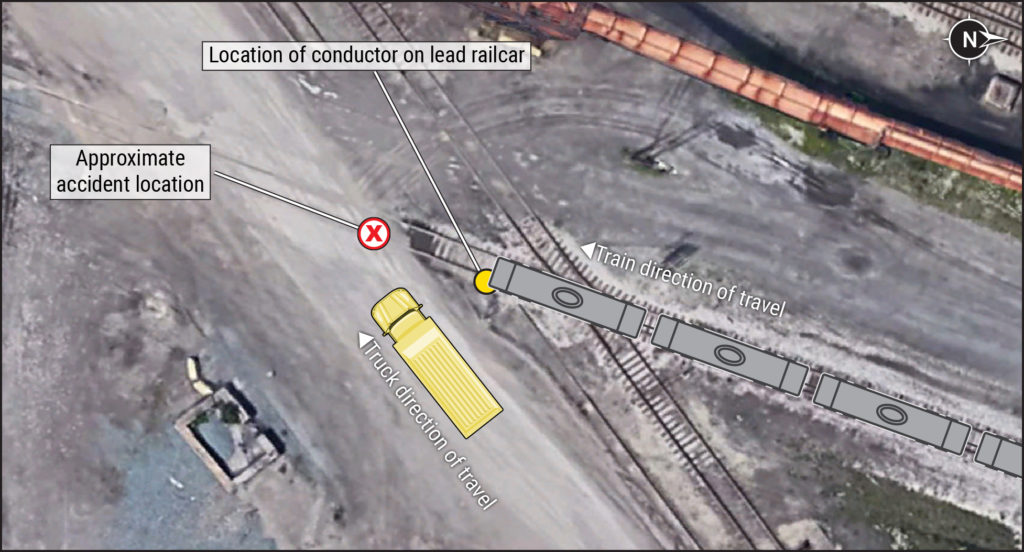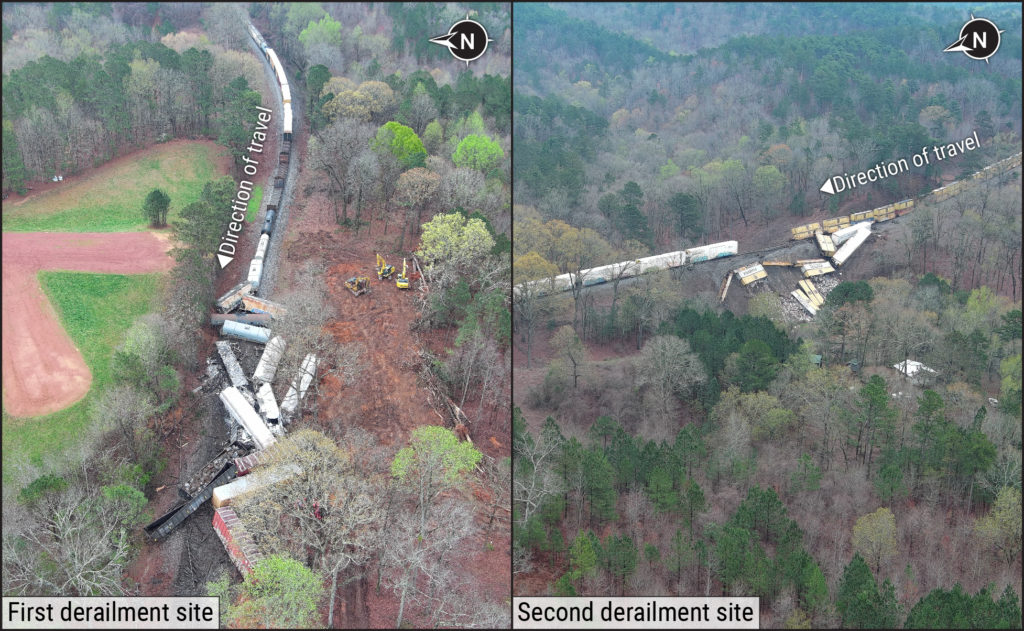
NTSB Issues Preliminary Reports on Three NS Derailment Investigations
Written by Carolina Worrell, Senior Editor
Aerial view of March 4 derailment. (Courtesy of Clark County Emergency Management Agency)
The National Transportation Safety Board (NTSB) has issued preliminary reports on three ongoing Norfolk Southern (NS) derailments that occurred March 4, March 7 and March 9.
On March 4, 2023, westbound NS mixed freight train 179LC04 derailed 28 railcars near Springfield, Ohio. Twenty-one of the derailed railcars were loaded and seven were empty; none were carrying hazardous materials (hazmat). The derailment downed a powerline, which caused about 47 homes to lose power. No injuries were reported. NS estimated damages to equipment, track, and signal infrastructure to be about $2.6 million. Visibility conditions at the time of the derailment were daylight and clear; the weather was 51°F with no precipitation.
The crew of train 179LC04 consisted of an engineer and a conductor in the lead locomotive. The train was composed of three head-end locomotives, two mid-train distributed power units, and 212 railcars. The train was 13,470 feet long and weighed about 17,966 tons.
After this derailment, on March 8, 2023, NS began removing 517 National Steel Car railcars from service until their wheelsets can be replaced.
Additionally, the Association of American Railroads (AAR) issued an equipment inspection order on March 9, 2023, advising railroads to inspect and remove from service wheelsets that were mounted by National Steel Car between August 2022 and March 2023.
NTSB has initiated an investigation, which includes the Federal Railroad Administration (FRA), the Public Utilities Commission of Ohio, NS, and National Steel Car, focusing on wheelsets, and has requested that NS recover eight wheelsets from two of the derailed railcars; photographs taken on scene after the derailment show that three wheels from these wheelsets exhibited movement on their axles.
According to NTSB’s preliminary report, the agency has placed an investigative hold on these wheelsets, additional wheelsets and other truck component from the accident train, and wheelsets from elsewhere in the NS fleet for examination. The wheelsets and other components were delivered to an NS facility in Altoona, Penn., for an examination performed before all parties that began on March 15, 2023.
According to NTSB, the investigation is ongoing, and any future investigative activity will focus on “failure analysis of the subject wheelsets and on industry-wide standards and practices for railcar wheel and axle assembly processes, specifications, and quality control.

On March 7, a NS conductor on NS train C75B106 was killed when the train he was riding collided with a dump truck as they simultaneously entered a private highway-railroad grade crossing (private grade crossing) in the Cleveland-Cliffs Incorporated steel plant in Cleveland, Ohio.
The conductor was riding on the end platform of the lead railcar during a shoving movement when he was pinned between the railcar and the dump truck during the collision. NS and TMS International (the truck owner) estimated total damages to equipment to be about $42,000. Visibility conditions at the time of the accident were dark and clear; the weather was 34°F with no precipitation.
The crew of train C75B106 consisted of an engineer in the locomotive cab and the conductor. The train was composed of one locomotive and 12 mixed railcars: four residue tank cars and eight empty covered hopper cars. The dump truck was driven by a TMS International employee and was hauling rock at the time of the collision. Cleveland Cliffs surveillance camera data reviewed by NTSB investigators show the dump truck traveling south through the plant, stopping at the private grade crossing, and then proceeding through the crossing. Based on event recorder data, the train was traveling about 9 mph at the time of the collision; the maximum authorized speed within the steel plant was 10 mph. The private grade crossing where the accident occurred was equipped with stop signs facing both directions of approach.
According to the preliminary report, NTSB investigators, while on scene, reviewed data from surveillance cameras and the locomotive event recorder, conducted sight distance observations at the private grade crossing, and completed interviews.
As a result of this accident, the FRA on March 16, 2023, issued “Safety Advisory 2023-02: Highway-Rail Grade Crossing and Shove Movement Accident,” noting “the importance of proper training, oversight, job briefings, and crew communication to protect safety at highway-railroad grade crossings.”
NTSB’s investigation, which includes the FRA, the Occupational Safety and Health Administration (OSHA); NS; the Brotherhood of Locomotive Engineers and Trainmen (BLET); the International Association of Sheet Metal, Air, Rail and Transportation Workers (SMART); TMS International; and Cleveland Cliffs, is ongoing.
According to NTSB, future investigative activity will focus on “industry-wide operational rules for conductors riding equipment through highway–railroad grade crossings and Cleveland-Cliffs’ methods of protection at private grade crossings.”

On March 9, westbound NS mixed freight train 245A109 derailed two locomotives and 37 railcars on the Alabama East End District of its Gulf Division in Anniston, Ala.
The derailment involved two sections of the train, resulting in two derailment sites. At the first site, located near the head end of the consist, two locomotives and 29 railcars derailed. At the second site, located near the rear end of the consist, eight railcars derailed. A total of three tank cars carrying hazmat derailed: one containing sodium hydrosulfide residue and two containing ferrous chloride residue. The tank cars remained intact and did not release hazmat. There were no reported fatalities or injuries. NS estimated damages to equipment, track, and signal infrastructure to be about $2.9 million. At the time of the accident, visibility conditions were clear with early morning daylight; the weather was 57°F with no precipitation.
The crew of train 245A109 consisted of one engineer and one conductor. The train was composed of six locomotives and 108 railcars; 34 railcars were loaded, 74 were empty, and two of the locomotives were being transported as waybill locomotives. The waybill locomotives were not equipped with alignment control couplers, which resist lateral coupler movement under compressive in-train forces. NS operating rule L-212 prohibits coupling together locomotives without alignment control couplers when those locomotives will be dead-in-tow. The waybill locomotives were coupled together and picked up from Bluffton, Ind., on February 24, 2023. An NS inspection performed before the first movement involving the coupled waybill locomotives did not identify the absence of alignment control couplers.
According to the preliminary report, NTSB investigators, while on scene, examined railroad equipment and track conditions; reviewed data from the signal system, wayside defect detectors, and the lead locomotive’s event recorder and forward-facing and inward-facing image recorders; and completed interviews.
NTSB’s investigation, which includes the FRA; the Alabama Public Service Commission, NS, SMART, BLET, and the Brotherhood of Maintenance of Way Employes Division (BMWED), is ongoing.
According to NTSB, future investigative activity will focus on “NS communication, maintenance, and inspection practices; locomotive and railcar positioning; and train handling.”



